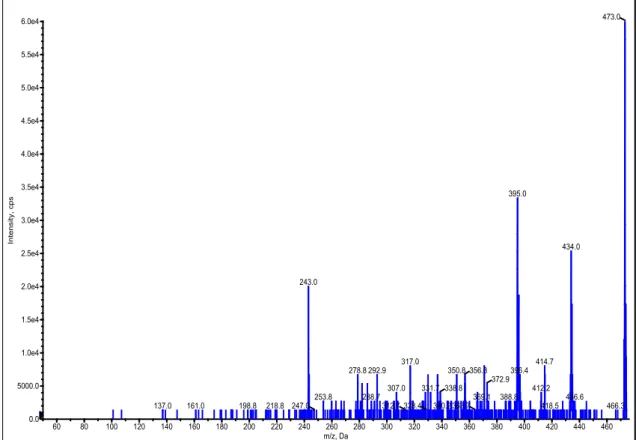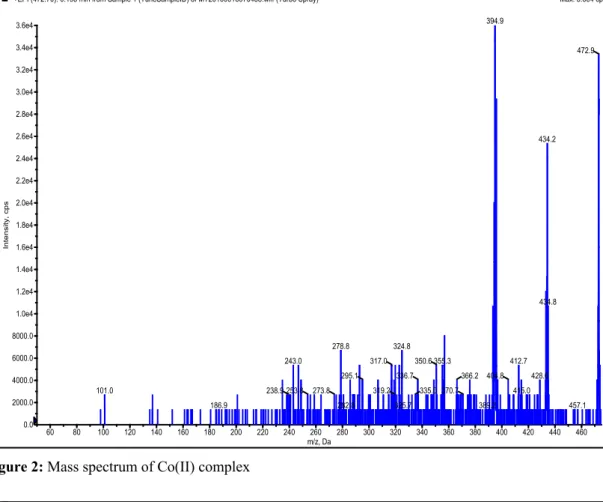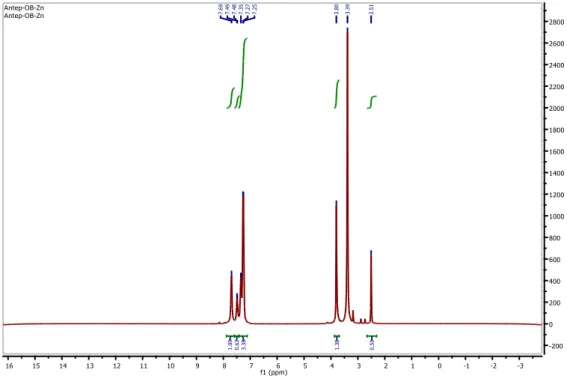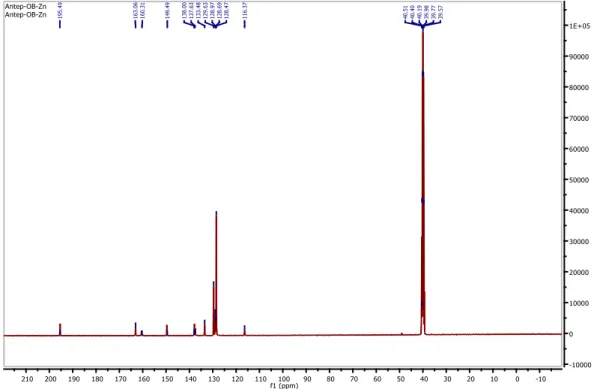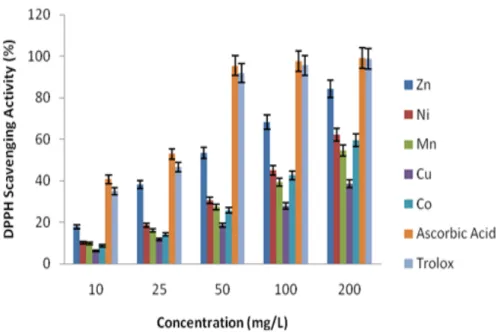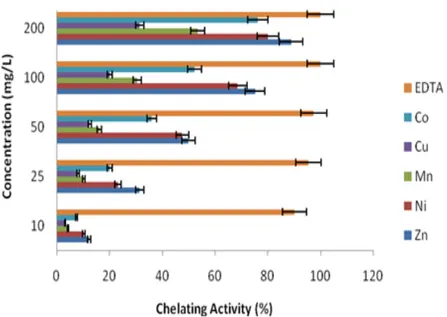* Corresponding Author DOI: 10.37094/adyujsci.589071
Template Synthesis, Characterization, Antioxidant Effects, DNA Cleavage and
Antimicrobial Studies of Zn
II, Ni
II, Mn
II, Cu
II, and Co
IIComplexes Containing
Pyridazinone Moiety
Özlem BAKIRCI1, Hatice Gamze SOGUKOMEROGULLARI2, Sadin OZDEMIR3, Mustafa Serkan
YALCIN4, Mehmet SÖNMEZ1,*
1Department of Chemistry, Faculty of Science and Arts, Gaziantep University, 27310, Gaziantep, Turkey
vansonmez@hotmail.com or msonmez@gantep.edu.tr, ORCID: 0000-0003-3127-666X ozlem_bakirci89@hotmail.com, ORCID: 0000-0002-2263-8617
2Medical Services and Techniques Department, Health Services Vocational School, Gaziantep University,
27310 Gaziantep, Turkey
hgcelikel@gantep.edu.tr, ORCID:0000-0002-0575-8131
3Food Processing Program, Technical Science Vocational School, Mersin University, TR-33343
Yenisehir, Mersin, Turkey
sadinozdemir@mersin.edu.tr, ORCID: 0000-0001-7384-7358
4Deparment of Chemistry and Chemical Processing Technologies, Technical Science Vocational School,
Mersin University, TR-33343 Yenisehir, Mersin, Turkey serkanyalcin@mersin.edu.tr, ORCID: 0000-0002-1134-5544
Received: 08.07.2019 Accepted: 26.03.2020 Published: 25.06.2020
Abstract
In this study, novel five Schiff base metal complexes derived from ZnII, NiII, MnII, CuII,
and CoII metal salts and 5-benzoyl-4-hydroxy-2-methyl-6-phenyl-2H-pyridazine-3-one with
o-aminophenol have been synthesized using a template method. Metal complexes were characterized by elemental analysis, FT-IR, UV-Vis, Mass and magnetic susceptibility.
Antioxidant effects, DNA cleavage, and antimicrobial studies of synthesized compounds were performed. DPPH scavenging and metal chelating activity was found to increase with concentration. The highest DPPH activity and ferrous ion chelating activity were obtained from compound Zn. DNA cleavage studies indicated that all tested compounds were cleavage active at
the concentration of 100 mg/L. While all the synthesized compounds displayed antibacterial activity against E. hirae in order of Mn>Zn=Ni=Co>Cu. The compound Ni only showed antimicrobial activity against all microorganisms tested, especially against L. pneumophila subsp.
pneumophila with inhibition zone value equal to 13 mm.
Keywords: Template synthesis; Schiff base complex; Antioxidant activity; DNA cleavage;
Antimicrobial activity.
Piridazinon Yapısı İçeren ZnII, NiII, MnII, CuII ve CoII Komplekslerinin Şablon Sentezleri,
Karakterizasyonları, Antioksidan Etkileri, DNA Klevajı ve Antimikrobiyal Etkilerinin Araştırılması
Öz
Bu çalışmada template metodu ile o-aminofenol, 5-benzoil-4-hidroksi-2-metil-6-fenil-2H-piridazin-3-on ve ZnII, NiII, MnII, CuII ve CoII metal tuzlarından türeyen beş yeni Schiff baz
kompleksi sentezlenmiştir. Metal kompleksler elemental analiz, FT-IR, UV-Vis, kütle ve manyetik duyarlılık ile karakterize edilmiştir. Sentezlenen bileşiklerin antioksidan etkileri, DNA bölünmesi ve antimikrobiyal çalışmaları yapılmıştır. DPPH süpürme ve metal şelatlama aktivitesinin konsantrasyona bağlı olarak arttığı bulunmuştur. En yüksek DPPH aktivitesi ve demir iyon şelatlama aktivitesi Zn bileşiğinden elde edildi. Sentezlenen tüm bileşikler, Mn>Zn=Ni=Co>Cu sırasına gore E. hirae’ye karşı antibakteriyal aktivite sergilerken, sadece Ni bileşiği test edilen tüm organizmalara karşı, özellikle de L. pneumophila subsp. pneumophila’ya 13 mm’ye eşit inhibisyon zon değerinde antimikrobiyal aktivite göstermiştir.
Anahtar Kelimeler: Template sentez; Schiff baz kompleks; Antioksidan aktivite; DNA
bölünmesi; Antimikrobiyal aktivite.
1. Introduction
Oxidative stress is associated with production of reactive oxygen species (ROS) that are responsible for the damage of a range of cellular components [1]. Therefore, antioxidants play a very significant role in the living system in terms of protecting from oxidative stress and other chronic diseases. Nowadays, many scientists have been working on newly synthesized compounds or compounds derived from natural sources due to their antioxidant, anticancer, anticonvulsant, antitubercular, antimicrobial and anti-inflammatory activities [2, 3]. Therefore, the newly synthesized compounds are used in different fields such as molecular biotechnology, genetic engineering, drug designing. Schiff bases containing pyridazine ring are known to possess
a range of biological properties, including antibacterial, antifungal activities etc. [4]. Moreover, pyridazine derivatives and their metal complexes have various pharmacological activities [5-7]. For example, some drugs that contain the pyridazine ring in the structure are used as antihistaminic and sedative drug [6]. Pyridazinone metal complexes are rarely encountered in the literature. The complexes obtained by the template method are very limited. However, when the literature is examined, it has been observed that pyridazinone metal complexes also have antifungal, antibacterial and antitumor activity [4, 7].
In this study, we aimed to examine the antioxidant effects, DNA cleavage, and antimicrobial activities of five newly synthesized Schiff base ZnII, NiII, MnII, CuII, and CoII metal
complexes. In order to initiate this investigation the template synthesis and characterization of Schiff base complexes of ZnII, NiII, MnII, CuII, and CoII was initiated and these results are first
presented.
2. Materials and Methods 2.1. Chemicals and materials
All the reactants and solvents (95-99 % purity) were purchased from Aldrich or Merck and used without further purification. 5-Benzoyl-4-hydroxy-2-methyl-6-phenyl-2H-pyridazine-3-one was prepared according to the literature procedure [8]. Elemental analyses were measured on a Thermo Scientific Flash EA 2000 CHNS analyzer. Electronic absorption spectra were recorded on a PG Instruments T80+UV/Vis spectrometer. Infrared spectra were measured on a Perkin-Elmer Spectrum 100 FTIR spectrophotometer with an ATR sampling accessory. Mass spectra were obtained on a LC/MS/MS AB/SciEx 3200 Q Trap spectrometer.
2.2. General synthesis method of the complexes (1-5)
A methanolic solution (5 mL) of metal chloride (ZnCl2 (0.068 g), NiCl2 (0.064 g),
MnCl2·2H2O (0.080 g), CuCl2·2H2O (0.085 g) and CoCl2 (0.064 g), 0.5 mmol) was mixed with a
suspension of 5-Benzoyl-4-hydroxy-2-methyl-6-phenyl-2H-pyridazine-3-one (0.153 g, 0.5 mmol) and o-aminophenol (0.055 g, 0.5 mmol) in 15 mL of methanol. The reaction mixture was stirred for 2 hour at 70-80 °C, the precipitate was filtered off, washed with cold MeOH-H2O (1:1)
and Et2O, the complex was purified from slowly vapor diffusion of Et2O with a THF-methanol
solution of complex and then dried in vacuo (Scheme 1).
[ZnL(H2O)] complex (1): White solid; Yield 0.043 g (18 %); 185 °C decompose; IR,
(ATR)v, cm-1: 3285 (O-H); 3059 (C-H)
arom.; 3028, 2945 (C-H)aliph.; 1662 (C=O); 1577 (C=N);
-DMSO) δ (ppm);s, singlet; m, multiplet: 7.69-7.25 (m, 14H, Harm), 3.80 (s, 3H, CH3 protons); 13C NMR (400 MHz, d
6-DMSO) δ (ppm); δ 196.19 (C-O)pyridazine, 163.06 (C=N), 160.31
(C=O)pyridazine, 149.19 (C-O)phenyl, 138.00 (C=N)pyridazine, 137.63 (C-N=), 133.48, 129.63, 128.97,
128.69, 128.47, 116.37 (Aromatic carbons), 40.51 (CH3); UV (DMF, λmax nm, (Abs.)): 328
(0.223), 284 (0.693), 245 (1.724) nm; ESI-MS, m/z: 480.8 [Zn+L+H2O+1]+; Anal. Calc.
C24H19N3O4Zn (478.82): C, 60.20, H, 4.00, N, 8.78 Found: C, 61.07, H, 4.19, N, 8.50%.
[NiL(H2O)] complex (2): Green solid; Yield 0.054 g (23 %); 250 °C decompose; IR,
(ATR)v, cm-1: 3300 (O-H); 3062 (C-H)
arom.; 2940 (C-H)aliph.; 1664 (C=O); 1578 (C=N); 1362
(C-O); 1548 (C=C); 544 (M-(C-O); 514 (M-N); μeff: 2.55 B.M.; UV (DMF, λmax nm, (Abs.)): 336
(0.237), 285 (0.796), 245 (1.872) nm; ESI-MS, m/z: 473.0 [Ni+L+H2O+1]+; Anal. Calc.
C24H19N3NiO4 (472.12): C, 61.06, H, 4.06, N, 8.90 Found: C, 61.46, H, 4.63, N, 8.69%.
[MnL(H2O)] complex (3): Yellow solid; Yield 0.069 g (30 %); 187 °C decompose; IR,
(ATR)v, cm-1: 3350 (O-H); 3059 (C-H)
arom.; 3027, 2826 (C-H)aliph.; 1651 (C=O); 1578 (C=N);
1378 (C-O); 1540 (C=C); 532 (M-O); 510 (M-N); μeff: 1.75 B.M.; UV (DMF, λmax nm, (Abs.)):
345 (0.068), 288 (0.339), 245 (1.020) nm; ESI-MS, m/z: 469.7 [Mn+L+H2O+1]+; Anal. Calc.
C24H19MnN3O4 (468.36): C, 61.55, H, 4.09, N, 8.97 Found: C,61.75, H, 4.50, N, 8.46%.
[CuL(H2O)] complex (4): Green solid; Yield 0.039 g (17 %); 335 °C decompose; IR,
(ATR)v, cm-1: 3150 (O-H); 3059 (C-H)
arom.; 3027, 2826 (C-H)aliph.; 1651 (C=O); 1578 (C=N);
1378 (C-O); 1540 (C=C); 532 (M-O); 510 (M-N); μeff: 2.05 B.M.; UV (DMF, λmax nm, (Abs.)):
310 (0.367), 288 (0.339), 245 (1.020) nm; ESI-MS, m/z: 478.4 [Cu+L+H2O+1]+; Anal. Calc.
C24H19CuN3O4 (476.97): C, 60.43, H, 4.02, N, 8.81 Found: C,60.23, H, 3.89, N, 8.38%.
[CoL(H2O)] complex (5): Brown solid; Yield 0.097 g (42 %); 220 °C decompose; IR,
(ATR)v, cm-1: 3327 (O-H); 3059 (C-H)
arom.; 3027, 2935 (C-H)aliph.; 1663 (C=O); 1578 (C=N);
1360 (C-O); 1546 (C=C); 541 (M-O); 512 (M-N); μeff: 5.54 B.M; UV (DMF, λmax nm, (Abs.)):
349 (0.222), 285 (0.767), 245 (1.938) nm; ESI-MS, m/z: 472.9 [Co+L+H2O+1]+; Anal. Calc.
C24H19CoN3O4 (472.36): C, 61.02, H, 4.05, N, 8.90 Found: C,61.53, H, 4.57, N, 8.72%.
Scheme 1: Template synthesis of Schiff base metal complexes
N N H3C Ph Ph N O O O OH2 M
M: Cu(II) , Ni(II), Zn(II), Mn(II), Co(II)
N N CH3 O OH Ph O Ph + NH2 OH Metal Chloride MeOH
2.3. DPPH radical scavenging assay
Different solutions (0.5 ml) in dimethylformamide (DMF) of compounds and 2 mL of 2,2- diphenyl-1-picrylhydrazyl radical (DPPH) solution were incubated at 25 oC in the dark for half
an hour [9]. DPPH scavenging activity was measured spectrophotometrically at 517 nm. A control reaction without DMF solution of compounds was performed under the same conditions. DMF solution was used as blank control. Trolox and Ascorbic Acid were used as standards in order to compare with the results. DPPH scavenging activity was determined using following equation:
DPPH scavenging activity (%) = [1 - (A517 nm,sample/A517 nm,control)] ´ 100 (1) 2.4. Ferrous ion chelating activity
Metal chelating effects on ferrous ions displayed by the compounds were applied as reported by Hsu et al. [10]. 1 mL of the synthesized compounds at different concentrations, FeCl2×H2O (0.1 mL 2 mM), ferrozine-1,2,4-triazine (0.2 mL 5 mM), and methanol (3.7 mL) were
mixed in test tube and kept waiting for 10 min. The activity was measured spectrophotometrically at 562 nm. A control reaction without extract was performed under the same conditions. Metal chelating effect was calculated as follows:
Metal chelating effect (%) = [(A562nm,control - A562nm,sample) / A562 nm,control] ´ 100 (2)
Ethylene diamine tetra acetic acid (EDTA) was used as the positive control.
2.5. DNA cleavage activity
The DNA cleavage studies were carried out by using agarose gel electrophoresis. A mixture of pBR 322 plasmid DNA (0.1 mg/mL), Tris buffer (50 mMTris–HCl and NaCl buffer, pH 7.2) and the metal complexes (100 mg/L) were incubated at 37 ○C for 1.5 hour. After the incubation,
the loading buffer was added to the mixture prior to electrophoresis and the reaction mixture was electrophoresed for 1.5 hour at 80 V by using agarose gel. Tris-boric acid-EDTA was used as an electrophoresis buffer. The electrophoresis bands were visualized by UV-A light.
2.6. Antimicrobial activity
Antimicrobial activity of compounds was evaluated by using disk-diffusion method [11] against Enterococcus hirae (ATCC 10541), Bacillus cereus, Staphylococcus aureus (ATCC 6538), Legionella pneumophila subsp. pneumophila (ATCC 33152), Pseudomonas aeruginosa (ATCC 9027), Escherichia coli (ATCC 10536), and Candida albicans. B. cereus and Candida
3. Results and Discussion
Schiff base metal complexes occurred with template effect between coordination sites of o-aminophenol and 5-benzoyl-4-hydroxy-2-methyl-6-phenyl-2H-pyridazine-3-one on a metal center (Scheme 1). New synthesized metal complexes were obtained to the general formula of ML(H2O) where L is the anion of H2L. These metal complexes were investigated using various
spectroscopic techniques, such as FT-IR, UV-Vis, mass and magnetic susceptibility, elemental analysis, and molar conductivity. The investigation showed that the molar ratio obtained by the complexes was a 1:1 metal-ligand ratio. All of the complexes are air-stable at room temperature in the solid state, soluble in DMF, methanol and insoluble in water. Molar conductivity values measured for 10-3 M solution in DMF of these complexes fall in the range 1.41-2.83 μS/cm,
indicate the non-electronic nature for the metal complexes [12].
3.1. FT-IR spectra
The infrared spectral bands in the region 3150-3350 cm-1 for O-H stretching indicate the
presence of coordination water molecule in all the complexes. At the same time, in the spectra of all the complexes show in ν(C-O) at 1359-1378 cm-1 on complexation indicate that the phenolic
OH group undergoes deprotonation and is coordinated to the metal ions [7]. A broad intensity sharp bands due to ν(C=O) group pyridazine ring appeared at 1651-1664 cm-1 in the complexes.
The spectra of complexes displaying a band around 1577-1578 cm-1 was observed to C=N group
stretching. Additionally, the bands in the complexes at 544-532 cm-1 and 510-514 cm-1 are
attributed to the ν(M-O) and ν(M-N) vibrations, respectively [13].
3.2. Electronic spectra and magnetic measurements
In the electronic spectrum of the metal complexes showed bands between 245 and 288 nm, which can be attributed to π– π* transitions of the pyridazine and phenyl aromatic rings. The bands in the 310-349 nm range can be attributed to n→π* transitions of imine and carbonyl groups [14]. As expected according to magnetic measurement value of ZnII complex, this complex is
diamagnetic, therefore, tetrahedral geometry is suggested for 1. The observed magnetic moment values (µeff) of NiII complex was 2.95 B.M. which this magnetic moment value lie within the
range normally found for other tetrahedral NiII complexes [15]. The magnetic measurement values
of CoII, CuII, and MnII complexes are 4.02, 2.30 and 5.75 B.M respectively which reveal with
3.3. Mass spectra
Given that the synthesized complexes, their molecular ion peaks in the mass spectrum have a distinctive; the appearance of this molecular ion peak is strong evidence for the identity of the complexes. Molecular ion peaks of the metal complexes appeared to be in agreement with formula weight after adding on one proton at: m/z: 480.8 [Zn+L+H2O+1]+,m/z: 473.0 [Ni+L+H2O+1]+,
m/z: 469.7 [Mn+L+H2O+1]+,m/z: 478.4 [Cu+L+H2O+1]+, m/z: 472.9 [Co+L+H2O+1]+.The mass
spectrums of the Ni, Co and Zn metal complexes were shown in Fig. 1-3.
Figure 1: Mass spectrum of Ni(II) complex
+EPI (472.90): 0.249 min from Sample 1 (TuneSampleID) of MT20160616065239.wiff (Turbo Spray) Max. 6.0e4 cps.
60 80 100 120 140 160 180 200 220 240 260 280 300 320 340 360 380 400 420 440 460 m/z, Da 0.0 5000.0 1.0e4 1.5e4 2.0e4 2.5e4 3.0e4 3.5e4 4.0e4 4.5e4 5.0e4 5.5e4 6.0e4 In te n si ty, c p s 473.0 395.0 434.0 243.0 414.7 317.0 350.8 356.8 396.4 278.8 292.9 372.9 412.2 331.7 307.0 338.8 388.8 288.7 253.8 369.1 436.6 247.0 312.7328.4 340.2363.7 218.8 198.8 418.5 161.0 466.3 137.0
Figure 2: Mass spectrum of Co(II) complex
Figure 3: Mass spectrum of Zn(II) complex
+EPI (472.70): 0.198 min from Sample 1 (TuneSampleID) of MT20160616070458.wiff (Turbo Spray) Max. 3.6e4 cps.
60 80 100 120 140 160 180 200 220 240 260 280 300 320 340 360 380 400 420 440 460 m/z, Da 0.0 2000.0 4000.0 6000.0 8000.0 1.0e4 1.2e4 1.4e4 1.6e4 1.8e4 2.0e4 2.2e4 2.4e4 2.6e4 2.8e4 3.0e4 3.2e4 3.4e4 3.6e4 In te n si ty, c p s 394.9 472.9 434.2 434.8 278.8 324.8 355.3 243.0 317.0 350.6 412.7 295.1 336.7 366.2 404.8 428.6 335.0 319.2 415.0 273.8 253.8 238.9 370.7 101.0 389.2 282.8 325.7 186.9 457.1
+EPI (480.60): 0.200 min from Sample 1 (TuneSampleID) of MT20160616071355.wiff (Turbo Spray) Max. 7.2e4 cps.
60 80 100 120 140 160 180 200 220 240 260 280 300 320 340 360 380 400 420 440 460 480 m/z, Da 0.0 5000.0 1.0e4 1.5e4 2.0e4 2.5e4 3.0e4 3.5e4 4.0e4 4.5e4 5.0e4 5.5e4 6.0e4 6.5e4 7.0e4 7.2e4 In te n si ty, c p s 300.8 480.8 286.9 314.8 222.9 402.8 208.9 236.9 246.9 344.7 212.9 290.8 276.9 358.8 329.8 441.4 364.7 403.3 354.8 198.9 262.9 304.9 348.8 270.8 190.9 434.8 227.0 322.9 148.9 145.0 250.9 378.8 448.6 310.9 275.8 393.8 422.8 337.1 426.6 292.9
3.4. Proton and carbon nuclear magnetic resonance spectra
1H-NMR and 13C-NMR spectrums of the Zn complex (1) were recorded in d
6-DMSO as a
deuterated solvent. The 1H-NMR spectra of the Zn complex (1) exhibits signals due to protons of
phenyl and pyridazine rings as multiplex at δ 7.69-7.25 ppm (14 H) and CH3 protons as singlet at
3.80 ppm (3H) (Fig. 4). Water peak was found at 2.51 ppm. Since there are many aromatic rings in the structure of the Zn complex, the aromatic region is complicated in the 1H-NMR spectrum.
The13C-NMR spectra of the Zn complex (1) exhibits signals due to of pyridazine ring (C-O)
carbon at 196.19 ppm, azomethine carbon at 163.06 ppm, pyridazine ring carbonyl carbon at 160.31 ppm, phenyl ring (C-O) carbon at 149.19 ppm, pyridazine ring (C=N) carbon at 138.00 ppm, (C-N=) carbon at 137.63 ppm, aromatic carbons at 133.48-116.37 ppm and CH3 carbon at
40.51 ppm (Fig. 5).
Figure 5: 13C-NMR spectrum of Zn(II) complex 3.5. Antioxidant studies
3.5.1. DPPH scavenging activity
One of the most important factors that cause biological damage is free radicals. DPPH, a free radical compound that is stable at 25 ○C and was widely used as a screening method for free
radical scavenging activity of organic and inorganic compounds [19]. To determine the DPPH scavenging ability, various concentrations of compounds were tested by comparing with standard Ascorbic acid and Trolox. In Fig. 6, obtained results of the compounds on DPPH radical scavenging activity are presented. While the concentration was increased from 10 mg/L to 200 mg/L, DPPH ability increased from 6.1% to 38.6% mg/L and 17.8% to 84.3% mg/L for Cu and Zn, respectively. It was found that Cu had the lowest DDPH activity, while Zn had the highest. Trolox and Ascorbic acid displayed highest scavenging activity than tested other compounds. Similar results have been reported by Ağırtaş et al. [20]. The IC50 values of the novel
pyridazine-based ZnII, NiII, MnII, CuII and CoII complexes were found as 46.54, 120.09, 168.99, 269.59, and
152.66 mg/L, respectively. The results indicated that the existence of ZnII may contribute to the
Figure 6: Free radical scavenging activity of the compounds on DPPH radicals
3.6. Metal chelating activity
In order to determine the capability of the tested compounds to bind the oxidation, catalytic ferrous ion was applied in ferrous ion chelating activity test [10]. In this study, chelating activities of DMF solutions of compounds were investigated. As can be seen in Fig. 7, when the concentration of the compounds increased, the metal chelating activities of all tested compounds increased at all tested concentration. The chelating activities of the DMF solutions of compounds at 200 mg/L concentration were 88.9% for ZnII, 80.1% for NiII, 76.3% for CoII, 53.4% for MnII
and 31.6% for CuII. The IC
50 values of pyridazine-based ZnII, NiII, MnII, CuII, and CoII were also
determined as 48.82, 52.86, 184.46, 335.42, and 98.52 mg/L, respectively. According to ferrous ion chelating activity of Schiff base metal complexes, ZnII was almost as good chelator as positive
Figure 7: Metal chelating activity of compounds
3.7. Antimicrobial activity
Antimicrobial activity of the five newly synthesized compounds were examined by using disk-diffusion method and results are shown in Fig. 8. According to the results, only E. hirae was inhibited by all compounds and the antimicrobial activity was in order of Mn>Zn=Ni=Co>Cu. Compound 2 inhibited all microorganisms and displayed the highest antimicrobial activity against
L. pneumophila subsp. pneumophila with inhibition zone value equal to 13 mm.
3.8. DNA cleavage studies
As seen in Fig. 9, all tested compounds cleaved the supercoiled DNA in varying extents (Lane 2, 3, 4, 5 and 6). The untreated plasmid DNA (Lane 1) and plasmid DNA with 3% DMF (Lane 7) were performed as control groups. Form I (supercoiled DNA) was converted to form II (nicked circular DNA) and form III (linear DNA) at 100 μg/mL concentrations of all complexes. From experimental results we concluded that all of the tested compounds were active in cleavage. Therefore, these metal complexes can be used as alternative anti-cancer medicine after following toxicological test systems.
Figure 9: DNA cleavage of the metal complexes. Lane 1, pBR 322 DNA; lane 2, pBR 322 DNA + 100 μg/mL of Zn; lane 3, pBR 322 DNA + 100 μg/mL of Ni; lane 4, pBR 322 DNA + 100 μg/mL of Mn; lane 5, pBR 322 DNA + 100 μg/mL of Cu; lane 6, pBR 322 DNA + 100 μg/mL of Co; lane 7 pBR 322 DNA + 3%DMF
4. Conclusion
In conclusion, the novel pyridazine-based ZnII, NiII, MnII, CuII, and CoII Schiff base metal
complexes have been synthesized using the template method. The metal complexes were characterized by elemental analysis, UV-Vis, FT-IR, Mass, magnetic susceptibility. The newly synthesized compounds displayed antioxidant activity that directly proportional to the concentration of compounds. These compounds displayed moderate DPPH scavenging and metal chelating activity except compound Zn which displayed a potent antioxidant activity compared to the standards. On the basis of DNA cleavage results, all compounds completely broke the structure of form I and form II DNA. Inhibition efficiencies of the compounds were tested against seven microorganisms. According to the inhibition results, compound Ni inhibited all microorganisms and displayed the highest antimicrobial activity against L. pneumophila subsp.
pneumophila. Besides, all compounds inhibited only one microorganism called E. hirae. As a
result this novel compounds, especially Zn compound can be used as antioxidant agents and anti-cancer drug after mutagenic test assay.
Acknowledgement
References
[1] Bilgin, R., Yalcin, M.S., Yucebilgic, G., Koltas, I.S., Yazar, S., Oxidative stress in vivax
malaria, The Korean Journal of Parasitology, 50, 375-377, 2012.
[2] Bajpai, V.K., Baek, K.H., Kang, S.C., Antioxidant and free radical scavenging activities
of taxoquinone, a diterpenoid isolated from Metasequoia glyptostroboides, South African Journal
of Botany, 111, 93–98, 2017.
[3] Gali, R., Banothu, J., Gondru, R., Bavantula, R., Velivela, Y., Crooks, P.A., One-pot
multicomponent synthesis of indole incorporated thiazolylcoumarins and their antibacterial, anticancer and DNA cleavage studies, Bioorganic & Medicinal Chemistry Letters, 25, 106–112,
2015.
[4] Shebl, M., Adly, O.M.I., Abdelrhman, E.M., El-Shetary, B.A., Binary and ternary
copper(II) complexes of a new Schiff base ligand derived from 4-acetyl-5,6-diphenyl-3(2H)-pyridazinone: Synthesis, spectral, thermal, antimicrobial and antitumor studies, Journal of
Molecular Structure, 1145, 329-338, 2017.
[5] Lin, S., Liu, Z., Hu, Y., Microwave-enhanced efficient synthesis of diversified
3,6-disubstituted pyridazines, Journal of Combinatorial Chemistry,9, 742–744, 2007.
[6] Aleeva, G.N., Zhuravleva, M.V., Khafiz’yanova, R.K., The role of excipients in
determining the pharmaceutical and therapeutic properties of medicinal agents, Pharmaceutical
Chemistry Journal, 43, 230-234, 2009.
[7] Sönmez, M., Berber, I., Akbaş, E., Synthesis, antibacterial and antifungal activity of
some new pyridazinone metal complexes, European Journal of Medicinal Chemistry, 41, 101–
105, 2006.
[8] Akbas, E., Berber, I., Sener, A., Hasanov, B., Synthesis and antibacterial activity of
4-benzoyl-1-methyl-5-phenyl-1H-pyrazole-3-carboxylic acid and derivatives, Il Farmaco, 60, 23–
26, 2005.
[9] Blois, M.S., Antioxidant determinations by the use of a stable free radical, Nature, 181, 1199, 1958.
[10] Hsu, C., Chen, W., Weng, Y., Tseng, C., Chemical composition, physical properties,
and antioxidant activities of yam flours as affected by different drying methods, Food Chemistry,
83, 85–92, 2003.
[11] Kalemba, D., Kunicka, A., Antibacterial and antifungal properties of essential oils, Current Medicinal Chemistry, 10, 813–829, 2003.
[12] Roy, S., Mondal, T.K., Layek, A., Saha, R., Sinha, C., Structure, spectra and electrical
conductivity of Copper(I) and Silver(I) phosphino bridging mixed ligand complexes with Coumarinyl Schiff base, Inorganica Chimica Acta, 469, 523-535, 2018.
[13] Hassan, N., El-Sonbati, A.Z., El-Desouky, M.G., Synthesis, characterization,
molecular docking and DNA binding studies of Cu(II), Ni(II), Zn(II) and Mn(II) complexes,
Journal of Molecular Liquids, 242, 293–307, 2017.
[14] Gao, X.S., Ni, C.C., Ren, X.M., Syntheses, crystal structures, photoluminescent and
magnetic properties of complexes of zinc(II) and copper(II) with Schiff-base ligands derived from 2,6- diacetylpyridine, Polyhedron, 138, 225-231, 2017.
[15] Fernández-Souto, P., Romero, J., García-Vázquez, J.A., Sousa, A., Perez-Lourido, P.,
[16] Orojloo, M., Zolgharnein, P., Solimannejad, M., Amani, S., Synthesis and
characterization of cobalt (II), nickel (II), copper (II) and zinc (II) complexes derived from two Schiff base ligands: Spectroscopic, thermal, magnetic moment, electrochemical and antimicrobial studies, Inorganica Chimica Acta, 467, 227-237, 2017.
[17] Khulbe, R.C., Singh, R.P., Bhoon, Y.K., Copper(II), nickel(II) and cobalt(II)
complexes of pyridyl and quinolylhydrazones of isatin and methylisatin: Ligand dependent stereochemistry, Transition Metal Chemistry, 8, 59-61, 1983.
[18] Adly, O.M.I., Shebl, M., El-Shafiy, H.F., Khalil, S.M.E., Taha, A., Mahdi, M.A.N.,
Synthesis, spectroscopic characterization, antimicrobial and antitumor studies of mono-, bi- and tri-nuclear metal complexes of a new Schiff base ligand derived from o-acetoacetylphenol,
Journal of Molecular Structure, 1150, 507-522, 2017.
[19] Kitzberger, C.S.G., Smania, J.A., Pedrosa, R.C., Ferreira, S.R.S., Antioxidant and
antimicrobial activities of shiitake (Lentinula edodes) extracts obtained by organic solvents and supercritical fluids, Journal of Food Engineering, 80, 631-638, 2007.
[20] Ağırtas, M.S., Cabir, B., Özdemir, S., Novel metal (II) phthalocyanines with
3,4,5-trimethoxybenzyloxy-substituents: Synthesis, characterization, aggregation behaviour and antioxidant activity, Dyes and Pigments, 96, 152-157, 2013.
